

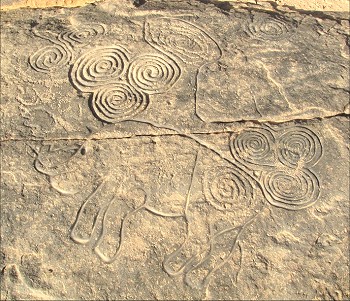
|
Oued Djerat (Tassili N'Ajjer), Algeria, November, 2019
|
Day 1. – Algiers - Illizi - Oued Djerat
The mouth of Oued Djerat is about 30 kilometres East of Illizi, easily accessible from Algiers with Air Algerie domestic flights. Departure day will be fixed to match the schedule of non-stop flights to Illizi (currently Fridays). The morning departure from Algiers requires everyone to reach Algiers the previous day, and spend a night at Algiers near the airport. With the flight ariving mid-morning, we should be at the mouth of the Oued Djerat by midday, permitting an early afternoon departure in order to make first camp already some way into the valley. We will use pack camels to carry the load, so we will be able to walk light needing only a bottle of water and camera gear to be with us during the day.
Day 2 - 6. - Along the Oued Djerat
Our daily routine will be adjusted to the pace of the camels: a longer march in the morning, lasting from around 8am till ~1pm, during which it is possible to cover 12-15 kilometres (camels walk more slowly than humans, but at a steadily 2.5-3kph pace, while we may go faster but will stop at rock art sites, so the camels will catch up and sometimes overtake. There will be a 1.5-2 hour rest at midday (depending on temperature) after which another 2.5-3 hour march may be completed before making camp for the evening. Lunch stops and camps will be managed to be near principal sites wherever possible.
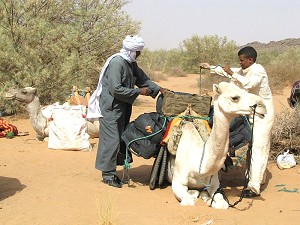
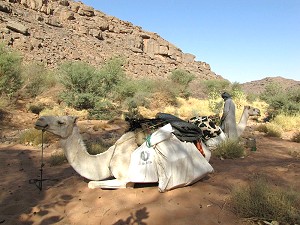
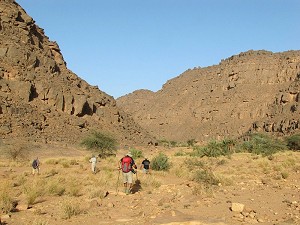
The Oued Djerat winds for about 80 kilometres generally southwards, rising until its headwaters reach the top of the plateau. For a stretch of about 60 kilometres the rocks along the sides and bottom of the valley are covered with engravings, plus there are several sites with paintings. We will need about 5 days to traverse the full length, with springs at several locations along the valley providing a secure source of water.
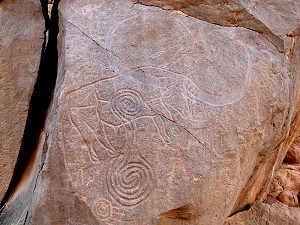
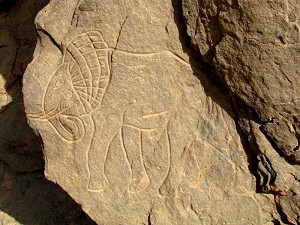
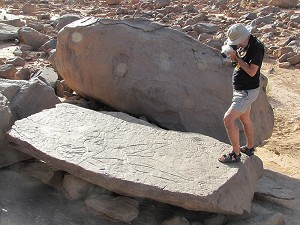
Day 7 - 8 - Fadnoun - Imirhou
From the head of the Wadi Djerat it will be another two days to cross the Fadnoun plateau towerds the East, and descend into the Oued Imirhou to reach the small village of the same name where we may meet the cars.
Day 09-10. Central Tassili - Djanet
From Imirhou we will drive to the main Illizi - Djanet road, stoping along the way as some very fine rock art sites where we will spend the night to make the best use of the late afternoon and early morning light. The next day we will continue towards Djanet, stoping at a few more sites before reaching the city to catch our overnight flight back to Algiers.
|
TIKADIOUINE The Tikadiouine shelter is one of the principal sites of the Iheren style, the finest manifestation of Saharan pastoralist rock art. While all Iheren style paintings depict cattle, human fgures and wild animals in a ver fine line drawing, the particular paintings at Tikaidouine take this to the xtreme, producing human figures that appear almost caricaturesque, with fuzzy hair not seen anywhere else. The shelter was discovered relatively recently, and the lack of visitors mean that it is in a pristine condition, with all figures clearly visible. |
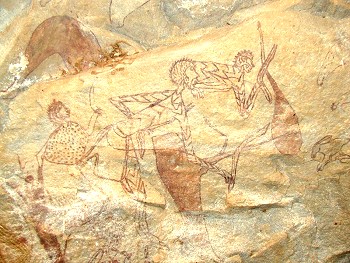
|
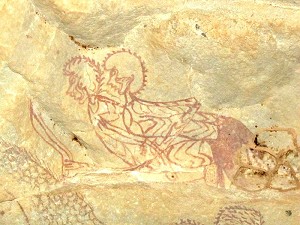 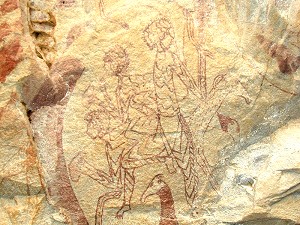 |
Day 10 - 16. Optional add-on: Trek up the Tassili du Tamrit
The plateau above Djanet has been closed to tourism since 2012 because of the closeness and easy access to the Libyan border. There is constant talk of allowing acess, should it be possible then there will be an extension of the trip to see the classic sites of Lhote (Tamrit, Tin Tazarift, Sefar, Jabbaren, etc.). This we will only know as we approach departure, we will coordinate with participants to discuss options. Alternately, a 5-6 day circuit of the Tadjelahine plateau (Iheren sites) may be done starting from Iherir before returning to Djanet.
For information on expected costs, planned dates and any further questions, please send me an email.
Back to planned expeditions...